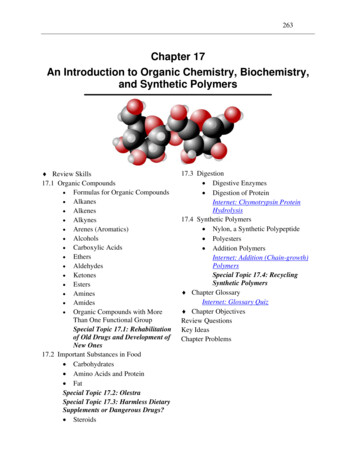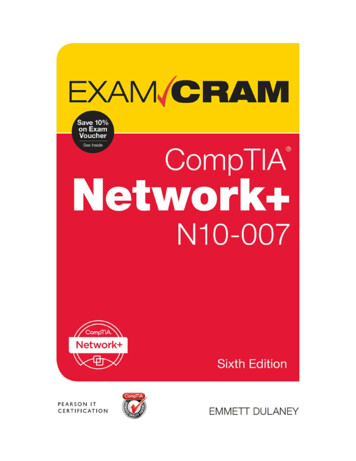
Transcription
263Chapter 17An Introduction to Organic Chemistry, Biochemistry,and Synthetic Polymers Review Skills17.1 Organic Compounds Formulas for Organic Compounds Alkanes Alkenes Alkynes Arenes (Aromatics) Alcohols Carboxylic Acids Ethers Aldehydes Ketones Esters Amines Amides Organic Compounds with MoreThan One Functional GroupSpecial Topic 17.1: Rehabilitationof Old Drugs and Development ofNew Ones17.2 Important Substances in Food Carbohydrates Amino Acids and Protein FatSpecial Topic 17.2: OlestraSpecial Topic 17.3: Harmless DietarySupplements or Dangerous Drugs? Steroids17.3 Digestion Digestive Enzymes Digestion of ProteinInternet: Chymotrypsin ProteinHydrolysis17.4 Synthetic Polymers Nylon, a Synthetic Polypeptide Polyesters Addition PolymersInternet: Addition (Chain-growth)PolymersSpecial Topic 17.4: RecyclingSynthetic Polymers Chapter GlossaryInternet: Glossary Quiz Chapter ObjectivesReview QuestionsKey IdeasChapter Problems
264Study Guide for An Introduction to ChemistrySection Goals and IntroductionsSection 17.1 Organic CompoundsGoals To describe carbon-based compounds, called organic compounds. To describe the different ways that organic molecules can be represented and show youhow to convert from one way to the others. To show how you can recognize different types of organic compounds.There are millions of different organic (carbon-based) compounds. The task of studying thembecomes much easier when you recognize that organic compounds can be categorizedaccording to structural similarities that lead to similarities in the compounds’ importantproperties. For example, instead of studying the alcohols methanol, ethanol, and 2-propanolseparately, you can study the characteristics of alcohols in general, because all alcohols havevery similar characteristics. This section introduces you to some of the different types oforganic compounds, shows you how your can recognize substances in each category, andshows you several ways of describing the structures of organic compounds.Section 17.2 Important Substances in FoodGoal: To describe the different types of chemicals found in our food: carbohydrates, aminoacids and proteins, fats and oils (triglycerides), and steroids.Your understanding of organic compounds can be applied to understanding biomolecules,which are organic compounds that are important in biological systems. Like the organiccompounds described in Section 17.1, recognizing that biomolecules can be placed incategories facilitates learning about them. You will learn about the structures of biomoleculesin the categories of carbohydrates, amino acids, proteins, triglycerides, and steroids.Section 17.3 DigestionGoal: To describe the chemical changes that take place in digestion.This section gives you a glimpse at the subject of biochemistry by describing some of thechemical changes of digestion. This includes a brief description of how enzymes facilitate thisprocess. See the section on our Web site that describes a proposed mechanism for an enzymereaction.Internet: Chymotrypsin Protein HydrolysisSection 17.4 Synthetic PolymersGoals To describe synthetic polymers, including nylon, polyester, polyethylene, polypropylene,poly(vinyl chloride), and polystyrene. To describe the recycling of synthetic polymers.Scientists have developed ways of making many synthetic polymers that are similar to naturalbiomolecules. This section shows you how some of these polymers are made and describestheir many different uses.See the section on our Web site that provides more information on one type of polymer.Internet: Addition (Chain-growth) Polymers
Chapter 17 – An Introduction to Organic Chemistry, Biochemistry, and Synthetic PolymersChapter 17 Maps265
266Study Guide for An Introduction to ChemistryChapter ChecklistRead the chapter quickly before the lecture that describes it.Attend class meetings, take notes, and participate in class discussions.Work the Chapter Exercises, perhaps using the Chapter Examples as guides.Study the Chapter Glossary and test yourself on our Web site:Internet: Glossary QuizStudy all of the Chapter Objectives. You might want to write a description of how youwill meet each objective.To get a review of the most important topics in the chapter, fill in the blanks in the KeyIdeas section.Work all of the selected problems at the end of the chapter, and check your answers withthe solutions provided in this chapter of the study guide.Ask for help if you need it.Web ResourcesInternet: Chymotrypsin Protein HydrolysisInternet: Addition (Chain-growth) PolymersInternet: Glossary Quiz
Chapter 17 – An Introduction to Organic Chemistry, Biochemistry, and Synthetic Polymers267Exercises KeyExercise 17.1 - Organic Compounds: Identify each of these structures as representing analkane, alkene, alkyne, arene (aromatic), alcohol, carboxylic acid, ether, aldehyde, ketone, ester,amine, or amide. (Obj c acidg.amide
268Study Guide for An Introduction to em.arene
Chapter 17 – An Introduction to Organic Chemistry, Biochemistry, and Synthetic Polymers269Exercise 17.2 - Condensed Formulas: Write condensed formulas to represent the Lewisstructures in parts (a) through (l) of Exercise 17.1. (Obj 2)a. CH3CH2CH2CH2CH2CH2CH3 or CH3(CH2)5CH3b. CH3CH2CH2CH2CH2CH2CH2CH2NH2 or CH3(CH2)7NH2c. CH3CH2CH2CH2OCH2CH2CH2CH3d. CH3CH2CO2CH2CH2CH2CH3 or CH3CH2COOCH2CH2CH2CH3e. CH3CH2CH2COCH2CH3f. CH3CH2CH2CH2CH2CH2CH2CH2CH2CH2CH2CO2H or CH3(CH2)10CO2Hor CH3CH2CH2CH2CH2CH2CH2CH2CH2CH2CH2COOH or CH3(CH2)10COOHg. (CH3)2CHCONH2h. (CH3)3CCH2CH2CHOi. (CH3)2C(OH)CH2CH3j. (CH3)2CCHCH2CH3k. CH3CH2N(CH3)2l. CH3CCC(CH3)3Exercise 17.3 - Line Drawings: Make line drawings that represent the Lewis structures inparts (a) through (j) of Exercise 17.1. (Obj 2)a.f.b.g.c.h.d.i.e.j.
270Study Guide for An Introduction to ChemistryReview Questions Key1. Draw a Lewis structure, a geometric sketch, a ball-and-stick model, and a space-filling modelfor methane, CH4.See Figure 12.4 of the textbook.2. Draw a Lewis structure, a geometric sketch, a ball-and-stick model, and a space-filling modelfor ammonia, NH3.See Figure 3.11 of the textbook.3. Draw a Lewis structure, a geometric sketch, a ball-and-stick model, and a space-filling modelfor water, H2O.See Figure 3.12 of the textbook.4. Draw a Lewis structure, a geometric sketch, a ball-and-stick model, and a space-filling modelfor methanol, CH3OH.5. The following Lewis structure represents a molecule of formaldehyde, CH2O. Draw ageometric sketch, a ball-and-stick model, and a space-filling model for this molecule.6. The following Lewis structure represents a molecule of hydrogen cyanide, HCN. Draw ageometric sketch, a ball-and-stick model, and a space-filling model for this molecule.7. The following Lewis structure represents a molecule of ethanamide, CH3CONH2. Draw ageometric sketch for this molecule.
Chapter 17 – An Introduction to Organic Chemistry, Biochemistry, and Synthetic Polymers271Key Ideas Answers8. Hydrocarbons (compounds composed of carbon and hydrogen) in which all of thecarbon-carbon bonds are single bonds are called alkanes.10. When a(n) small section of an organic molecule is largely responsible for the molecule’schemical and physical characteristics, that section is called a functional group.12. Compounds that contain the benzene ring are called arenes or aromatics.14. Ethers consist of two hydrocarbon groups surrounding an oxygen atom.16. Sugars are monosaccharides and disaccharides. Starches and cellulose are polysaccharides.18. Maltose, a disaccharide consisting of two glucose units.20. Sucrose is a disaccharide that contains glucose and fructose.22. Almost every kind of plant cell has energy stored in the form of starch. Starch itself has twogeneral forms, amylose and amylopectin.24. All the polysaccharides are polymers, a general name for large molecules composed ofrepeating units, called monomers.26. Protein molecules are polymers composed of monomers called amino acids.28. Condensation is a chemical reaction in which two substances combine to form a largermolecule with the release of a small molecule, such as water.30. The arrangement of atoms that are close to each other in the polypeptide chain is called thesecondary structure of the protein.32. The fat stored in our bodies is our primary long-term energy source.34. A process called hydrogenation converts liquid triglycerides to solid triglycerides by addinghydrogen atoms to the double bonds and so converting them to single bonds.36. A triglyceride that still has one or more carbon-carbon double bonds is an unsaturatedtriglyceride.38. As the starting material for the production of many important body chemicals, includinghormones (compounds that help regulate chemical changes in the body), the steroidcholesterol is necessary for normal, healthy functioning of our bodies.40. In digestion, disaccharides are broken down into monosaccharides (glucose, galactose, andfructose), polysaccharides into glucose, protein into amino acids, and fat into glycerol andfatty acids.42. The digestion of proteins begins in the stomach. The acidic conditions there weaken the linksthat maintain the protein molecules’ tertiary structure. This process is called denaturation,because the loss of tertiary structure causes a corresponding loss of the protein’s “natural”function.44. For an enzyme-mediated reaction to take place, the reacting molecule or molecules, whichare called substrates, must fit into a specific section of the enzyme’s structure called theactive site. A frequently used analogy for the relationship of substrate to active site is theway a key must fit into a lock in order to do its job. Each active site has (1) a(n) shape thatfits a specific substrate or substrates only, (2) side chains that attract the enzyme’s particularsubstrate(s), and (3) side chains specifically positioned to speed the reaction.46. When small molecules, such as water, are released in the formation of a polymer, thepolymer is called a condensation (or sometimes step-growth) polymer.48. Polyesters are made from the reaction of a(n) diol (a compound with two alcohol functionalgroups) with a di-carboxylic acid.
272Study Guide for An Introduction to ChemistryProblems KeySection 17.1 Organic Compounds50. Classify each of the following as organic or inorganic (not organic) compounds.a. sodium chloride, NaCl, in table saltinorganicb. hexane, C6H14, in gasolineorganicc. ethyl butanoate, CH3CH2CH2CO2CH2CH3, in a pineappleorganicd. water, H2O, in your bodyinorganic52. Identify each of these Lewis structures as representing an alkane, alkene, alkyne, arene(aromatic), alcohol, carboxylic acid, aldehyde, ketone, ether, ester, amine, or amide. (Obj 3)b.a.ketonec.alkaned.carboxylic acidamidef.e.etherg.aldehydeh.alkeneester
Chapter 17 – An Introduction to Organic Chemistry, Biochemistry, and Synthetic Polymersi.273j.alcoholalkynek.arene54. Write condensed chemical formulas to represent the Lewis structures in parts (a) through (j)of Problem 52. (For example, 2-propanol can be described as CH3CH(OH)CH3.) (Obj 2)a. CH3(CH2)4COCH3 or CH3CH2CH2CH2CH2COCH3b. CH3CH2CH(CH3)CH2CH(CH3)2or CH3CH2CH(CH3)CH2CH(CH3)CH3c. CH3(CH2)12COOH or CH3(CH2)12CO2Hd. CH3CH2CH2CONH2e. CH3CH2OCH(CH3)2 or CH3CH2OCH(CH3)CH3f. (CH3)2CHCHO or CH3CH(CH3)CHOg. CH2C(CH3)CHCH2h. CH3CH2COOCH3 or CH3CH2CO2CH3i. CH3CH2CH2CH(OH) CH(CH2OH)CH2CH3j. CH3CCCH356. Write line drawings to represent the Lewis structures in Parts (a) through (i) of Problem 52.(Obj 2)a.b.c.
274Study Guide for An Introduction to Chemistryd.e.f.g.h.i.58. The chemical structure of the artificial sweetener aspartame is below. Identify all of theorganic functional groups that it contains.
Chapter 17 – An Introduction to Organic Chemistry, Biochemistry, and Synthetic Polymers27560. Draw geometric sketches, including bond angles, for each of the following organicmolecules.a.b.c.63. Because the structure for a particular alkane can be drawn in different ways, two drawings ofthe same substance can look like isomers. Are each of the following pairs isomers ordifferent representations of the same thing?a.andisomersb.andsameandc.d.and65. Draw line drawings for three isomers of C5H12.isomerssame
276Study Guide for An Introduction to Chemistry67. Two of the three isomers of C3H8O are alcohols and one is an ether. Draw condensedstructures for these three isomers.CH3CH2CH2OHCH3CH(OH)CH3CH3OCH2CH369. Draw a Lewis structure for an isomer of C2H5NO that is an amide, and draw a second Lewisstructure for a second isomer of C2H5NO that has both an amine functional group and analdehyde functional group.Section 17.2 Important Substances in Food72. Identify each of the following structures as representing a carbohydrate, amino acid, peptide,triglyceride, or steroid. (Obj 4)a.amino acidb.carbohydratec.triglyceride
Chapter 17 – An Introduction to Organic Chemistry, Biochemistry, and Synthetic Polymersd.277steroid74. Identify each of the following structures as representing a monosaccharide, disaccharide, orpolysaccharide. (Obj monosaccharide
278Study Guide for An Introduction to Chemistry76. Identify each of the following as a monosaccharide, disaccharide, or polysaccharide.a. Maltosedisaccharideb. fructosemonosaccharidec. amylosepolysaccharided. cellulose polysaccharide78. Describe the general difference between glucose and galactose. (Obj 6)Glucose and galactose differ in the relative positions of an –H and an –OH on one oftheir carbon atoms. In the standard notation for the open-chain form, glucose andgalactose differ only in the relative position of the –H and –OH groups on the fourthcarbon from the top.80. What saccharide units form maltose, lactose, and sucrose? (Obj 7)maltose – 2 glucose unitslactose – glucose and galactosesucrose – glucose and fructose82. Describe the similarities and differences between starches (such as amylose, amylopectin,and glycogen) and cellulose. (Obj 8)Starch and cellulose molecules are composed of many glucose molecules linked togetherin a similar way, but cellulose has different linkages between the molecules than starch.See Figure 17.21 in the textbook.
Chapter 17 – An Introduction to Organic Chemistry, Biochemistry, and Synthetic Polymers27984. Explain why glycine amino acid molecules in our bodies are usually found in the secondform shown below rather than in the first. (Obj 11)One end of the amino acid has a carboxylic acid group that tends to lose an H ion, andthe other end has a basic amine group that attracts H ions. Therefore, in the conditionsfound in our bodies, amino acids are likely to be in the second form.85. Using Figure 17.22 of the textbook, draw the Lewis structure of the dipeptide that has alaninecombined with serine. Circle the peptide bond in your structure.87. Show how the amino acids leucine, phenylalanine, and threonine can be linked together toform the tripeptide leu-phe-thr. (Obj 12)
280Study Guide for An Introduction to Chemistry89. When the artificial sweetener aspartame is digested, it yields methanol as well as the aminoacids aspartic acid and phenylalanine. Although methanol is toxic, the extremely low levelsintroduced into the body by eating aspartame are not considered dangerous, but for peoplewho suffer from phenylketonuria (PKU), the phenylalanine can cause severe mentalretardation. Babies are tested for this disorder at birth, and when it is detected, they areplaced on diets that are low in phenylalanine. Using Figure 17.22 of the textbook, identify theportions of aspartame’s structure that yield aspartic acid, phenylalanine, and methanol.91. Describe how disulfide bonds, hydrogen bonds, and salt bridges help hold protein moleculestogether in specific tertiary structures. (Obj 14)Each of these interactions draws specific amino acids in a protein chain close together,leading to a specific shape of the protein molecule. Disulfide bonds are covalent bondsbetween sulfur atoms from two cysteine amino acids (Figure 17.27 in the textbook).Hydrogen bonding forms between –OH groups in two amino acids, such as serine orthreonine, in a protein chain (Figure 17.28 in the textbook). Salt bridges are attractionsbetween negatively charged side chains and positively charged side chains. For example,the carboxylic acid group of an aspartic acid side chain can lose its H , leaving the sidechain with a negative charge. The basic side chain of a lysine amino acid can gain an H and a positive charge. When these two charges form, the negatively charged asparticacid is attracted to the positively charged lysine by a salt bridge (Figure 17.29 in thetextbook).
Chapter 17 – An Introduction to Organic Chemistry, Biochemistry, and Synthetic Polymers28194. Draw the structure of the triglyceride that would form from the complete hydrogenation ofthe following triglyceride. (Obj 19)Section 17.3 Digestion96. When you wash some fried potatoes down with a glass of milk, you deliver a lot of differentnutritive substances to your digestive tract, including lactose (a disaccharide), protein, and fatfrom the milk and starch from the potatoes. What are the digestion products of disaccharides,polysaccharides, protein, and fat? (Obj 20)Disaccharides – monosaccharides (glucose and galactose from lactose)Polysaccharides (starch) – glucoseProtein – amino acidsFat – glycerol and fatty acids
282Study Guide for An Introduction to Chemistry98. Explain why each enzyme acts only on a specific molecule or a specific type of molecule.(Obj 22)Before an enzyme reaction takes place, the molecule or molecules that are going to react(called substrates) must fit into a specific section of the protein structure called the activesite. Because the active site has a shape that fits specific substrates, because it has sidechains that attract particular substrates, and because it has side chains in distinctpositions that speed the reaction, each enzyme will only act on a specific molecule or aspecific type of molecule.Section 17.4 Synthetic Polymers100. Explain why Nylon 66 is stronger than Nylon 610. (Obj 24)One of the reasons for the exceptional strength of nylon is the hydrogen bonding betweenamide functional groups. A higher percentage of amide functional groups in nylonmolecules’ structures leads to stronger hydrogen bonds between them. Thus changing thenumber of carbon atoms in the diamine and in the di-carboxylic acid changes theproperties of nylon. Nylon 610, which has four more carbon atoms in the di-carboxylicacid molecules that form it than for Nylon 66, is somewhat weaker than Nylon 66 and hasa lower melting point.102. Describe the similarities and differences between the molecular structures of low-densitypolyethylene (LDPE) and high-density polyethylene (HDPE). (Obj 26)Polyethylene molecules can be made using different techniques. One process leads tobranches that keep the molecules from fitting closely together. Other techniques havebeen developed to make polyethylene molecules with very few branches. Thesestraight-chain molecules fit together more efficiently, yielding a high-densitypolyethylene, HDPE, that is more opaque, harder, and stronger than the low-densitypolyethylene, LDPE.104. Both ethylene and polyethylene are composed of nonpolar molecules. Explain why ethyleneis a gas at room temperature while polyethylene is a solid at the same temperature.Nonpolar molecules are attracted to each other by London forces, and increased size ofmolecules leads to stronger London forces. Polyethylene molecules are much larger thanthe ethylene molecules that are used to make polyethylene, so polyethylene moleculeshave much stronger attractions between them, making them solids at room temperature.
264 Study Guide for An Introduction to Chemistry Section Goals and Introductions Section 17.1 Organic Compounds Goals To describe carbon-based compounds, called organic compounds. To describe the different ways that organic molecules can be represented and show you how to convert from one way to the others. To show how you ca











